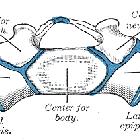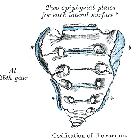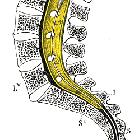Sacrum





The sacrum is the penultimate segment of the vertebral column and also forms the posterior part of the bony pelvis. It transmits the total body weight between the lower appendicular skeleton and the axial skeleton.
Gross anatomy
The sacrum is an irregularly-shaped bone, shaped roughly like an inverted triangle, with its base superior and apex inferior. It is curved with an anterior concavity and posterior convexity.
The sacrum consists of five fused sacral vertebral and costal segments (numbered one-to-five) that form a central sacral body and paired sacral alae (singular ala), which arise laterally from S1.
As the sacrum develops, costal elements form the parts superior, lateral and inferior to the anterior sacral foramina. Posterior sacral foramina are wholly formed by the vertebral part, the costal elements lying lateral to the lateral sacral crest.
Superiorly, the anterior lip of the S1 is called the sacral promontory. Anteriorly, the lines of vertebral fusion can be seen as four transverse ridges. Posteriorly, the spinous processes are fused to form the median sacral crest.
Through the center of the sacral body passes the triangular-shaped sacral canal, which is the continuation of the lumbar vertebral canal. It terminates inferiorly at the sacral hiatus and contains sacral and coccygeal nerve roots, spinal meninges (to the level of S2) and filum terminale. The spinal epidural space extends to the sacral hiatus. First to fourth sacral nerve roots exit the sacrum via four paired anterior and posterior foramina. The fifth sacral nerve root exits via the sacral hiatus.
Articulations
- lumbosacral: superiorly, the sacrum articulates with the inferior endplate of L5 via the L5/S1 intervertebral disc; superior articular processes of S1 articulate with the L5 inferior articular facets to form the L5/S1 facet (zygapophyseal) joints
- joint surfaces face anteroposteriorly (note interlumbar segments face laterally)
- sacrococcygeal: inferiorly, the sacrum articulates with the first coccygeal segment
- sacroiliac: laterally, the sacral ala articulates with the ilium
Attachments
Ligamentous
- lumbosacral and iliolumbar ligaments: reinforce the lumbosacral articulation
- ligamentum flavum (S1 to L5): closes the spinal/sacral canal posteriorly
- sacroiliac ligaments: reinforce the sacroiliac joint - anterior, posterior and interosseous
- sacrotuberous ligament
- sacrospinous ligament
- sacrococcygeal ligaments: superficial part of the posterior sacrococcygeal ligament closes the sacral hiatus
- anterior longitudinal ligament
Musculotendinous
- iliacus muscle: anterosuperiorly
- piriformis muscle: anteroinferiorly
- erector spinae muscle: posteriorly
- gluteus maximus: posteriorly
- coccygeus
Relations
Anteriorly:
- fascia of Waldeyer, peritoneum (S1-S2), rectum (S3-S5), lymph nodes
- in the midline from above down:
- median sacral vessels
- superior rectal artery
- on each side of the midline
- sympathetic chain
- lateral sacral vessels
- piriformis
- sacral plexus
- coccygeus
- levator ani
- in the midline from above down:
Arterial supply
- iliolumbar arteries (posterior division of internal iliac artery)
- superior and inferior lateral sacral arteries (posterior division of internal iliac artery)
- median sacral artery (abdominal aorta)
Venous drainage
- via vertebral venous plexus to:
- median sacral vein (to either common iliac vein or IVC)
- lateral sacral vein (to internal iliac vein)
Variant anatomy
Read more in our article on anatomical variants of the sacrum
Related pathology
- sacral lesions
- Tarlov (perineural) cysts
- anterior sacral meningocele
- classification of sacral fractures
- pelvic insufficiency fractures
Siehe auch:
und weiter:

